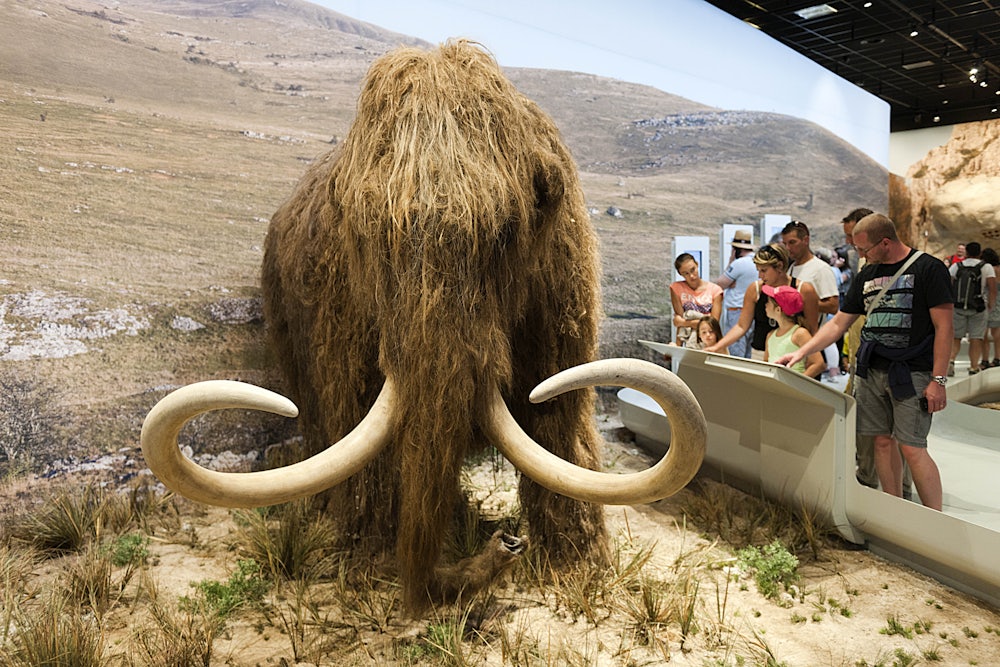“How much would you pay to see a woolly mammoth?” asked a recent headline in the MIT Technology Review. Colossal Biosciences, which calls itself the world’s first de-extinction company, intends to make that more than a hypothetical. At its founding last year, Colossal generated a thunderclap of publicity for its announced goal of creating mammoths in its labs and releasing them in a park in Siberia. Media coverage offered an inspiring image of the tusked giants, who weighed up to 10 tons, once again trampling across the snowy earth.
But there was a problem—and no, not just the technical hurdle of restoring extinct species via biotechnology. The region of Siberia Colossal had in mind, Sakha, has a thriving underground trade in mammoth tusks. Specimens preserved in ice and riverbeds can be passed off as elephant ivory: One find can generate enough income for a hunter to feed his family for a year. So George Church, a Harvard geneticist and co-founder of Colossal, told CNN that in order to avoid its creations being poached, Colossal was considering bringing them back without tusks.
Mammoths without their iconic body part symbolize a crucial fact about de-extinction: Any scientific breakthrough like this will be subject to political and economic considerations as well. Indeed, Colossal’s other co-founder, entrepreneur Ben Lamm, now says Russia’s invasion of Ukraine has caused it to pause its Siberian plan and begin investigating locations in Alaska instead.
Wherever newly revived animals might end up—and the woolly mammoth isn’t the only animal on Colossal’s agenda—it’s increasingly apparent that de-extinction projects require a legal framework. Currently it’s unclear whether the patchwork of laws in various countries on genome editing, animal use, and other topics amount to much regulation of de-extinction at all. But whether to bring back extinct species should ultimately be up to governments, not private firms such as Colossal.
Interest in Colossal and de-extinction more broadly reflect our increasing ability to reengineer other species. In 2000 the bucardo, a wild goat native to France and Spain, went extinct. Three years later, a team that included scientists from Advanced Cell Technology, a U.S. firm, used cells taken from the last living bucardo to create embryos that were inserted in surrogate goat and goat-bucardo mothers. Of the seven pregnancies that ensued, one resulted in a live birth. The animal lived for several minutes, during which de-extinction was briefly a reality.
Creating a clone that is genetically identical to a donor animal, as happened with the bucardo, requires a living cell from the donor. That’s not possible with mammoths, so Colossal says it will use gene-editing tools to make the genome of Asian elephants, the mammoth’s closest living relative, more mammoth-like.
Gene-editing technology currently allows researchers to make thousands of genetic changes simultaneously, whereas 1.5 million genetic differences separate elephants from mammoths. Some critics say that because of this, Colossal, rather than bringing back the mammoth, is really working toward the birth of a mammoth-like elephant. Colossal would seem to agree. Its website says the company’s long-term goal is “a cold-resistant elephant with all of the core biological traits of the Woolly Mammoth. It will walk like a Woolly Mammoth, look like one, sound like one.”
This plan raises many concerns. Mammoths are estimated to have eaten 400 pounds of grass and plants a day. Depending on how many were introduced, their ecological impact could be significant. De-extinction proposals therefore need to take into account the interests of people and animals living near introduction sites. Giving birth to a mammoth would also likely require a surrogate mother elephant, all species of which are endangered, calling into question their use. Finally, scientists suggest that mammoths may have gone extinct because of their inability to adapt to the warmer climate that followed an ice age. Before creating animals in their image, we will want evidence that they can survive our own period of global warming.
There are currently no laws designed to ensure that de-extinction is carried out in an environmentally responsible way. In some instances, endangered species regulations might apply. Species have been known to remain listed under the Endangered Species Act for decades after disappearing (often because scientists were hoping for a sighting that never came). A restoration project involving an extinct animal still listed as endangered might require federal approval. But the applicability of existing law to these cases is unclear. And since mammoths and many other species went extinct before 1967, when the list was introduced, they have never been listed.
Revising the Endangered Species Act to explicitly apply to de-extinct animals would be a welcome step. An example of what that could mean in practice is provided by the black-footed ferret project, which also involved advanced bioscience. In 2020, a team of scientists coordinated by Revive and Restore, a biotechnology firm, cloned a ferret that died in the 1980s.* Their goal was to expand the limited genetic diversity of existing populations. Before the company could go ahead, it had to obtain an endangered species recovery permit. Requiring an equivalent permit for de-extinction would narrow the legal gap between creating an endangered animal and creating an extinct one.
American legislation, however, is unlikely to be enough. In addition to Russia, Colossal also has its eye on Australia, where it says it wants to reintroduce the thylacine, or Tasmanian tiger, which went extinct in 1936. Any country where de-extinction occurs will need to regulate it. De-extinction ideally would also be subject to treaties such as the Convention on Biological Diversity (which the United States, alone among countries, has not ratified) or the Convention on International Trade in Endangered Species of Wild Fauna and Flora (to which the U.S. is a party). Amending these or other international instruments is necessary given not only the global reach of de-extinction firms but the possibility of de-extinct animals crossing national borders.
Existing laws and treaties cannot address all of the issues de-extinction raises. “Won’t Somebody Please Think of the Mammoths?” was the title of a 2018 academic article that noted that mammoths are social creatures whose welfare has received scant attention in the de-extinction debate. Creating one solitary mammoth to be confined in a zoo, for example, would be especially cruel. We should also hope that future de-extinctions avoid the invasive procedures used in the bucardo project, which saw scientists insert embryos in over 50 potential mothers in order to create those seven pregnancies. (Colossal, to its credit, says it hopes eventually to use artificial wombs. But not only are these still at the drawing board, they raise questions about how calf-mother bonding, which infant mammals depend on to develop, would occur.)
And
what is a genetically engineered species, anyway? How should we classify
animals whose genes are edited to make them resemble a long-vanished species?
Those who say the genes of an elephant, however modified, cannot result in a
mammoth are using a definition of species that requires strict genetic
similarity, which some biologists and philosophers reject. Elephants and mammoths
share over 99 percent of their DNA, and the genetic profile of any species can
change over time, through adaptation and genetic drift. If so, then Colossal’s
creations could still be mammoths, their genetic distinctiveness
notwithstanding.
This question, too, has profound legal ramifications. De-extinction as Colossal envisions it is perhaps best understood as attempting to create animals that are visually and functionally similar to extinct models, whether or not they are the same species. But because genetic editing could be said to result in new species, de-extinction firms may someday argue that lab-grown animals are their creations, which they should be able to patent.
Co-founder Lamm says that Colossal is only patenting spin-off technologies that can be applied to human health care. “Any technologies we develop which have an application to conservation will be given to the world for free,” he told me by email. But Colossal is not the only firm that has expressed an interest in de-extinction. Patenting de-extinct animals could not only make environmental regulations harder to enforce, it is likely to make the well-being of the animals even more of an afterthought. Making it illegal to patent a de-extinct species, while it would not address every ethical concern, would protect the animals’ interest in not becoming intellectual property.
Regulating de-extinction is better than banning it: Biotechnology is evolving, and the case for de-extinction could change with it. But as things stand now, the case for de-extinction is weak. While bringing back a species that recently disappeared has some appeal given how many species are being destroyed, the reality is that extinction is often due to human encroachment on animals’ habitats. Reversing that trend enough for a restored species to flourish would require taking on entrenched economic and political interests. If that were easy to do, there would be no extinction crisis to begin with.
Colossal says that mammoths in Sakha, should they ever arrive, would slow the melting of local permafrost in various ways, such as by trampling the snow cover that locks in heat from the summer sun. If true, that would also slow the release of greenhouse gases from the melting ground. But critics dispute the science on which this theory rests. Even if it is sound, given the time and expense that would be required to introduce enough mammoths to make a difference, mammoth de-extinction is likely to be an inefficient response to climate change. And there are probably more effective uses for conservation resources.
De-extinction advocates reply that environmental economics is not zero sum, and that companies like Colossal will generate new funding for conservation efforts. But this assumes that de-extinction will be an effective form of conservation. And it ignores the fact that some of Colossal’s funding has already come from the government, which obliges us to think hard about where it otherwise could have gone.
The company’s investors include the Central Intelligence Agency, through its nonprofit venture capital arm, In-Q-Tel. (The agency’s rationale—that it is less interested in de-extinction than the bioengineering possibilities it may unlock—is, admittedly, not very reassuring.) The Fish and Wildlife service, meanwhile, is estimated to require more than double its current congressional funding to protect species under the Endangered Species Act. Against that backdrop, it’s disappointing to see a de-extinction firm receive public funding of any kind.
All of this raises the worry that de-extinction may turn out to be another instance of the “environmentalism of the rich.” In his 2018 book of that name, political scientist Peter Dauvergne noted the depressing frequency with which environmental rhetoric is used to justify activities that have negligible environmental value and only benefit the wealthy. Prior to starting Colossal, George Church received $100,000 in funding from Peter Thiel, the billionaire supporter of libertarian and Republican causes, and Colossal’s current investors include, among other Silicon Valley names, the Winklevoss twins, best known for their Facebook litigation and Bitcoin investment. Regulating de-extinction will help ensure that whatever conservation potential it may have is not undermined by the desire of rich investors to cash in on our fascination with charismatic megafauna. Maybe someday mammoths should once again rule the earth. Mammon, though, is a different story.
* This piece has been corrected to reflect that not not all the scientists involved in the 2020 ferret project were employed by Revive and Restore.










